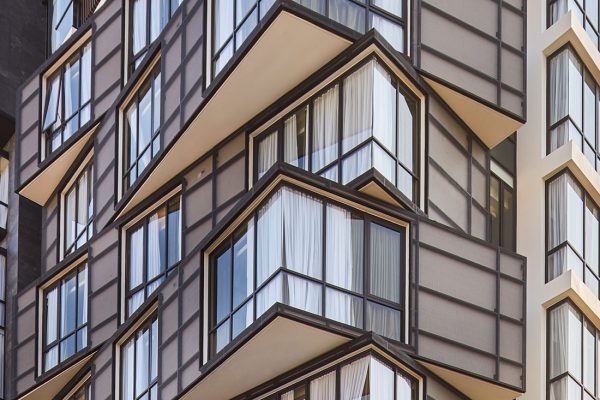As Cambodia’s once-sleepy French-built capital Phnom Penh reinvents itself at an ever-quickening pace, leading architecture firm Re-Edge is finding new ways to stay ahead of the curve.

The interior of Lumiere hotel (left) and Hun Chansan (right). Portrait by KHAMERA/Dy Pech
April 6th, 2018
The meeting room at Hun Chansan’s Re-Edge office, located down a typically leafy road in the centre of Phnom Penh, is ringed by scale models of the works of Vann Molyvann, the Cambodian architect often described as the “man who built Cambodia”.
Responsible for some of the Kingdom’s most cherished structures, including the 1964 ‘Olympic’ Stadium, he was at the forefront of a style known as ‘New Khmer Architecture’, designing more than 100 buildings under the patronage of the late King Norodom Sihanouk.
“Until recently, we didn’t have office buildings, shopping malls and hotels,” says Hun, “but now there is a more global aspect to Cambodia. People travel to other countries, and then come back inspired.” The architect could just as easily be describing himself: on a family visit to Singapore in 1996, aged just 15, his parents decided to leave him in the Lion City with a guardian.
“Cambodia was very unstable at that time. There was an economic crisis, so I was left there and spent a year learning English and Chinese.” Afterwards, he enrolled at a government school, which is where he discovered art.
Quickly developing a passion, he went on to study architecture at Northeastern University in Boston. “Everyone I knew was studying management, marketing or accounting, but I wanted to be something different—not a businessman.” For Hun, the subject held worlds of possibility: “Architecture is not just art—it’s science and innovation, it allows you to tell an audience about who you are. That’s why buildings have to be art, not just functional.”

He references being a fan of the way the narrow subterranean entrance at Frank Gehry’s Guggenheim Museum in Bilbao draws people in, an approach he has flipped on its head with his design for Phnom Penh’s planned Noro Mall, where an open-air plaza will begin your journey through a multi-layered space, crisscrossed with interlocking passageways.
“For instance, I suppose my signature is to chisel away at the traditional block, and break it down into human scale, something that people can relate to and engage with. I like to create movement, and play with light and shadows,” he adds.
This approach is also apparent in his striking design for boutique hotel Lumiere, a kilometre to the north, which provides multiple views of the city from floors twisted at angles to each other, much akin to a Rubik’s Cube in progress.

I’m now curious where the name of his firm comes from. “My master’s thesis was ‘Re-Edging Retails’, and I focused on a bleak urban block in Boston, ‘re-edging’ it and turning it in a different direction, using space to create a feeling of community. Then it was theory—now I’m doing it in practice.”
INDESIGN is on instagram
Follow @indesignlive
A searchable and comprehensive guide for specifying leading products and their suppliers
Keep up to date with the latest and greatest from our industry BFF's!

The undeniable thread connecting Herman Miller and Knoll’s design legacies across the decades now finds its profound physical embodiment at MillerKnoll’s new Design Yard Archives.

CDK Stone’s Natasha Stengos takes us through its Alexandria Selection Centre, where stone choice becomes a sensory experience – from curated spaces, crafted details and a colour-organised selection floor.

London-based design duo Raw Edges have joined forces with Established & Sons and Tongue & Groove to introduce Wall to Wall – a hand-stained, “living collection” that transforms parquet flooring into a canvas of colour, pattern, and possibility.
The internet never sleeps! Here's the stuff you might have missed

With projects shortlisted for Habitus House of the Year 2025, Anthony Gill and Jason Gibney join the podcast to discuss the state of housing in Australia today.

COX Architecture uses saturated colour and hotel-style amenity across the historic St Peters location, designed for Coronation Property.

The World Architecture Festival has named The Holy Redeemer Church and Community Centre of Las Chumberas in La Laguna, Spain as World Building of the Year 2025, alongside major winners in interiors, future projects and landscape.